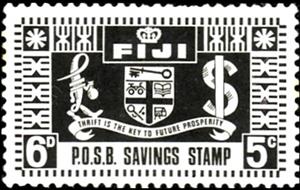Stamp: Post Office Savings Bank (POSB) - Coat of arms (Fiji 1968)
Post Office Savings Bank (POSB) - Coat of arms (Fiji 1968)
01 January (Fiji ) within release Savings goes into circulation Stamp Post Office Savings Bank (POSB) - Coat of arms face value 6 Fijian penny
| Stamp Post Office Savings Bank (POSB) - Coat of arms in catalogues | |
|---|---|
| Colnect codes: | Col: FJ S1968-01 |
Stamp is square format.
Denomination in dual currency: 6d / 5c Revenue Reverend cat. no: S6|
Data entry completed
50%
|
|
|---|---|
| Stamp Post Office Savings Bank (POSB) - Coat of arms in digits | |
| Country: | Fiji |
| Date: | 1968-01-01 |
| Emission: | Other |
| Format: | Stamp |
| Face Value: | 6 Fijian penny |
Stamp Post Office Savings Bank (POSB) - Coat of arms it reflects the thematic directions:
A bank is a financial institution that accepts deposits from the public and creates a demand deposit while simultaneously making loans.Lending activities can be directly performed by the bank or indirectly through capital markets
A coat of arms is an heraldic visual design on an escutcheon (i.e. shield), surcoat, or tabard. The coat of arms on an escutcheon forms the central element of the full heraldic achievement which in its whole consists of shield, supporters, crest, and motto. A coat of arms is traditionally unique to an individual person, family (except in the United Kingdom), state, organisation or corporation.
In British heraldry, a coronet is any crown whose bearer is less than sovereign or royal in rank, irrespective of the crown's appearance. In other languages, this distinction is not made, and usually the same word for crown is used irrespective of rank (German: Krone, Dutch: Kroon, Swedish: Krona, French: Couronne, etc.) In this use, the English coronet is a purely technical term for all heraldic images of crowns not used by a sovereign, and implies nothing about the actual shape of the crown depicted. A Coronet is another type of crown, but is reserved for the lower ranks of nobility like Marquesses and Marchionesses, Earls and Countesses, Barons and Baronesses, and some Lords and Ladies. The specific design and attributes of the crown or coronet signifies the hierarchy and ranking of its owner.
A symbol is a mark, sign, or word that indicates, signifies, or is understood as representing an idea, object, or relationship. Symbols allow people to go beyond what is known or seen by creating linkages between otherwise very different concepts and experiences. All communication (and data processing) is achieved through the use of symbols. Symbols take the form of words, sounds, gestures, ideas, or visual images and are used to convey other ideas and beliefs. For example, a red octagon is a common symbol for "STOP"; on maps, blue lines often represent rivers; and a red rose often symbolizes love and compassion. Numerals are symbols for numbers; letters of an alphabet may be symbols for certain phonemes; and personal names are symbols representing individuals.




